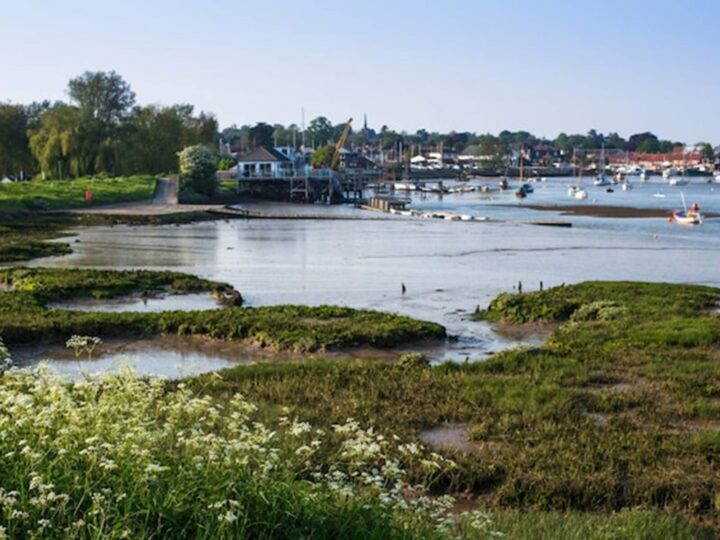Link to article by Sarah Baxter – 26.02.22
With its wild spaces under threat from development, explore this beautiful patch of England while you can.
Woodbridge on the River Deben was the starting point for walker Sarah Baxter.
The sunset was outrageous. What began as a dreamy watercolour – blush brushstrokes across a blue-grey sky, swirling silver river, pale reeds nodding, everything fluid – had turned into a rave of hot-pink and tangerine. A rave for one, as I stood alone on Snape Warren, in the psychedelic gloaming, listening to the tree twitter and incoming geese. I stayed on the heath as long as I dared, until the celestial shindig began to wind down and there was just enough light to see me safely along the trail, down the lane and to the Golden Key’s roaring fire.
Walking in Britain’s cooler months – before foliage covers the trees – has its upsides. Especially in Suffolk where, as well as the potential for huge, swashbuckling skies, the nakedness of the woods makes wildlife easier to spot. Also, the going is remarkably good, especially in the Sandlings, the once extensive and now rare lowland heath habitat, just inland from the coast, with well-drained sandy soil that remains mostly mud-free year-round.
More surprising, though, is the wealth of options. “Due to the way the land has been settled over the centuries, and the patterns of movement, Suffolk has one of the highest densities of walking trails in the country,” says David Falk, the county’s green access manager.
There are more than 2,000 miles of public rights of way here, plus thousands of acres of open-access land. Embracing this, and on the back of research showing people are walking 25 per cent further and for 25 per cent longer than before, the county has launched an app dedicated to walking, cycling and horse riding trails. So off-season be damned; the time was right to head east for a hike or two.
Though the app features routes county-wide, I stuck within the Suffolk Coast & Heaths AONB, drawn by its promise of mudlessness and abundant birdlife – plus a handy train line. There is a wider element of “enjoy it while you can” urgency to visit here. Parts of the AONB are threatened by massive development, including plans for a new nuclear plant at Sizewell and a carbuncle of Wembley-sized substations near the village of Friston; I spotted almost as many “Save Our Sandlings!” posters en route as ducks on Minsmere Scrape.
I began in Woodbridge; my aim was to follow the long-distance Sandlings Walk up to Southwold (around 50 miles), with detours to explore other trails. My first foray was one of these detours, an easy loop from Melton station, across the River Deben and around Sutton Hoo. The site was virtually empty on a bright February morning as I strolled through pine and birch to reach the new viewing tower (opened late 2021) to look over the famous Anglo-Saxon burial mounds. Barely discernible at ground level, from 56ft up they’re revealed, spreading rash-like across the low grass – 1,300-year-old pimples once full of treasures.
Plenty more mounds and tumuli kept me company as I zigzagged northwards on the Sandlings Walk – the region is rife with archaeological interest and, given the discoveries at Sutton Hoo, you can’t help but wonder what might lurk under your every footstep. A medieval rabbit warren hid amid the Scots pines and rusty bracken of Sutton Heath, and on Upper Hollesley Common, a Bronze Age barrow burst from the heather. So I kept my eyes peeled as I progressed via abandoned airfields, lonely churches and sheltered woodland (being sure to look extra hard for UFOs in Rendlesham Forest…).

The pretty town of Thorpeness CREDIT: Getty
After the astonishing Snape sunset, the following day took me across more classic, easy-going Sandlings; Tara, bar lady at the Golden Key and (in her words) “not a natural runner”, credited these soft trails with keeping her injury-free. Indeed, I bounced along, via the marshes, reed beds and woodland of North Warren, the toytown tweeness of Thorpeness, the big, beachside ball of Sizewell B and the bird smorgasbord that is Minsmere. And the bouncing – or at least toe-tapping – continued into the evening as I stayed at the excellent Eel’s Foot Inn: Thursday happened to be folk night and the bar filled with singers, strummers, flautists and Celtic harpists twiddling until last orders.
I bounced a bit less the next morning – not on account of the Adnams ale, but the weather. After a dazzling dawn – rosé skies, deer in the hedgerows, a marsh harrier fly-by – the rain started at Dunwich Heath and didn’t let up. But it was February after all. And, finally slopping into Southwold, I consoled myself at Sole Bay Fish where, not only was the crab salad sweet and delicious, but they let me dry my gloves on the radiator.
My final hike – the Southwold-Halesworth rail walk, to link to my train home – was a trail of two halves. The way to Blythburgh was wonderful, crossing heather-clad heath, delving into aromatic pines and following the wide river to reach the “cathedral of the marshes” – Blythburgh’s great flint and flushwork church was flooded with winter sunshine, adding extra divinity to the angels soaring on its beams.
However, the riverside path beyond soon disintegrated into water and reeds, and all the smugness of my sludge-less strolling sank into the mire of the River Blyth. Eventually I waded to an alternative route, relieved to find a solid country lane. So relieved that, as I passed a dog-walking old gent, I yelled “Lovely afternoon!”
“Aye,” he replied, “but a bit wet underfoot.”
Yes, indeed. This one-of-many rights of way is best, perhaps, enjoyed in spring – or at least in dry weather. So make hay while the sun shines – and before the Sizewell developers move in.
For walks across the county, and to download the new app, visit Discover Suffolk (discoversuffolk.org.uk). The next Suffolk Walking Festival will be held May 14-29 2022
Article by By Sarah Baxter











